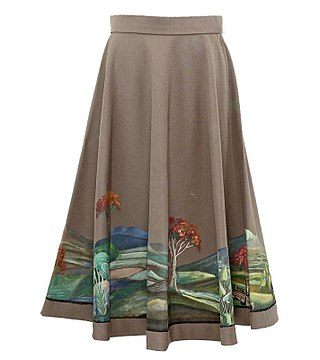
A skirt is the lower part of a dress or a separate outer garment that covers a person from the waist downwards.
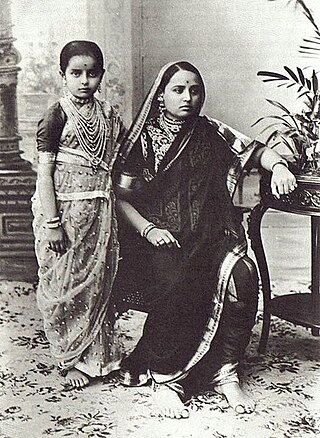
A sari is a women's garment from the Indian subcontinent, that consists of an un-stitched stretch of woven fabric arranged over the body as a robe, with one end attached to the waist, while the other end rests over one shoulder as a stole (shawl), sometimes baring a part of the midriff. It may vary from 4.1 to 8.2 metres in length, and 60 to 120 centimetres in breadth, and is form of ethnic wear in India, Sri Lanka, Nepal, Bangladesh and Pakistan. There are various names and styles of sari manufacture and draping, the most common being the Nivi style. The sari is worn with a fitted bodice also called a choli and a petticoat called ghagra, parkar, or ul-pavadai. It remains fashionable in the Indian subcontinent today.

A kurta is a loose collarless shirt or tunic worn in many regions of South Asia, and now also worn around the world. Tracing its roots to Central Asian nomadic tunics, or upper body garments, of the late-ancient- or early-medieval era, the kurta has evolved stylistically over the centuries, especially in South Asia, as a garment for everyday wear as well as for formal occasions.
Clothing in India varies with the different ethnicities, geography, climate, and cultural traditions of the people of each region of India. Historically, clothing has evolved from simple garments like kaupina, langota, achkan, lungi, sari, to rituals and dance performances. In urban areas, western clothing is common and uniformly worn by people of all social levels. India also has a great diversity in terms of weaves, fibers, colors, and the material of clothing. Sometimes, color codes are followed in clothing based on the religion and ritual concerned. The clothing in India also encompasses a wide variety of Indian embroidery, prints, handwork, embellishments, and styles of wearing clothes. A wide mix of Indian traditional clothing and western styles can be seen in India.
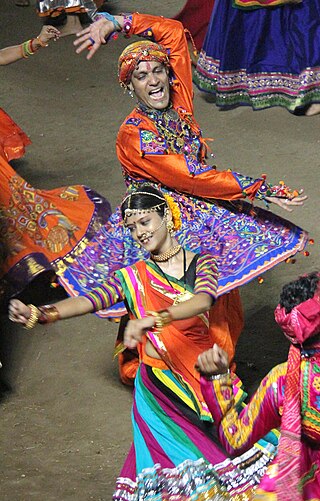
Garba is a form of Gujarati dance which originates from the state of Gujarat, India. The name is derived from the Sanskrit term Garbha. Many traditional garbas are performed around a centrally lit lamp or a picture or statue of the Hindu goddess Durga. Traditionally, it is performed during the nine-day Hindu festival Navaratri. Either the lamp or an image of the Goddess, Durga is placed in the middle of concentric rings as an object of veneration.

A choli is a blouse or a bodice-like upper garment that is commonly cut short leaving the midriff bare, it is worn along with a sari in the Indian subcontinent. The choli is also part of the ghagra choli costume in the Indian subcontinent.
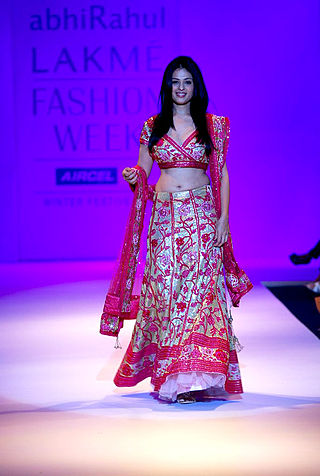
The lehenga, lehnga or langa or लेहंगा is a form of ankle-length skirt from the Indian subcontinent. Different patterns and styles of traditional embroidery are used to decorate lehenga. Gota patti embroidery is often used for festivals and weddings. The lehenga, also known as the ghagra, is a traditional Indian garment that became popular in the 16th century, mainly in North India. The lehenga became a favorite attire for Mughal women of all ages and classes due to its royal appeal and convenience The lehenga is sometimes worn as the lower portion of a gagra choli or langa voni. Ghagra in Hindi, was also used to refer to the half slip or petticoat, a skirt worn as an undergarment below the sari.
A langa voni is a traditional dress worn in South India by girls between puberty and marriage. It is also known as the two-piece sari or half sari. Girls younger than this may wear it on special occasions.
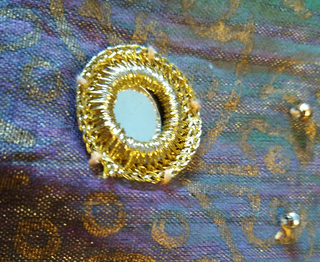
Shisheh, Kawan jo kam or abhla bharat embroidery, or mirror-work, is a type of embroidery which attaches small pieces of mirrors or reflective metal to fabric. Mirror embroidery is common throughout Asia, and today can be found in the traditional embroidery of the Indian subcontinent, Afghanistan, China, and Indonesia.
Pakistani clothing refers to the ethnic clothing that is typically worn by people in the country of Pakistan and by Pakistanis. Pakistani clothes express the culture of Pakistan, the demographics of Pakistan, and cultures from Punjab, Sindh, Balochistan, Khyber Pakhtunkhwa, Gilgit-Baltistan, and Kashmir regions of the country. The clothing in each region and culture of Pakistan reflect weather conditions, way of living, the textiles and embroidery used and its distinctive style which gives it a unique identity among all cultures.

A lehenga-style sari is a modern garment introduced in India that blends elements of the traditional sari and lehenga choli. A lehenga-style sari is normally 4.5 metres to 5.5 metres long. To wear one, unlike a sari, one does not have to form pleats but may simply tuck and drape.

Indian wedding clothes are elaborate set of clothes worn by the bride, bridegroom, and other relatives attending the wedding.

Shalwar kameez is a traditional combination dress worn by women, and in some regions by men, in South Asia, and Central Asia.

The Punjabi ghagra is a four-piece outfit known as tewar or 'ti-or' which was traditionally worn by Punjabi women throughout the Punjab region with the outfit comprising a head scarf (Phulkari), kurta or kurti, ghagra and either a suthan or the Punjabi salwar (trousers). In modern times, the ghagra is worn by women in parts of Haryana, rural parts of south West Punjab, parts of Himachal Pradesh and during performances of Giddha in East Punjab.

The luanchari is a full-dress ethnic garment of India. It is made up of two parts stitched together: the upper part, or choli, is a kind of blouse or bodice, and the lower part, or lehanga, is a long skirt. The two parts are typically made from the same fabric, but may vary in colour.

In the ancient Punjab region, people wore cotton clothing. Both men and women wore knee-length tops. A scarf was worn over the tops which would be draped over the left shoulder and under the right. A large sheet would be further draped over one shoulder which would hang loose towards the knees. Both male and female wore a dhoti around the waist. Modern Punjabi dress has retained this outfit but over its long history has added other forms of dress.
Sindhi clothing are a part of the Sindhi culture. Sindhi women and men wear the Shalwar Qameez or the Kurta with Pyjama. Women also wear Sari or ghagra. However, before the adoption of the Shalwar kameez, kurta, the Sari as well as other articles of clothing, Sindhis had their own traditional costumes.
Kurti top is an upper garment worn in the Indian subcontinent encompassing waistcoats, jackets and blouses.
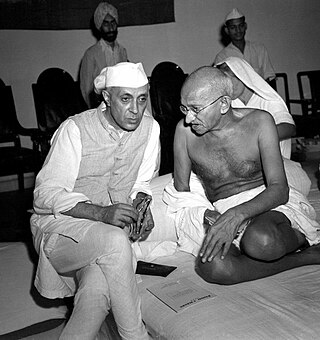
Sadri, also known as a Waskat or Bandi, is a vest-jacket worn by men in South Asia, while women sometimes wear a similar waistcoat known as a Koti. In Europe and America, the sadri became known as a Nehru vest.

Poshak (पोशाक), also called Vāstra (वस्त्र) is the Hindi term used for the complete attire used in the vedic period. As mentioned in Sanskrit literature and Buddhist Pali literature during the 6th century BC, the costumes belonging to the Vedic and post-Vedic period 1500 BCE to 350 BCE consisted of the antariya, which is the lower garment, the uttariya, which is a veil worn over the shoulder or the head, and the stanapatta, which is a chest band. The modernday Sari is one of the evolved poshak earlier known as Sattika that was single garment to wrap around the waist and cover the head.

































